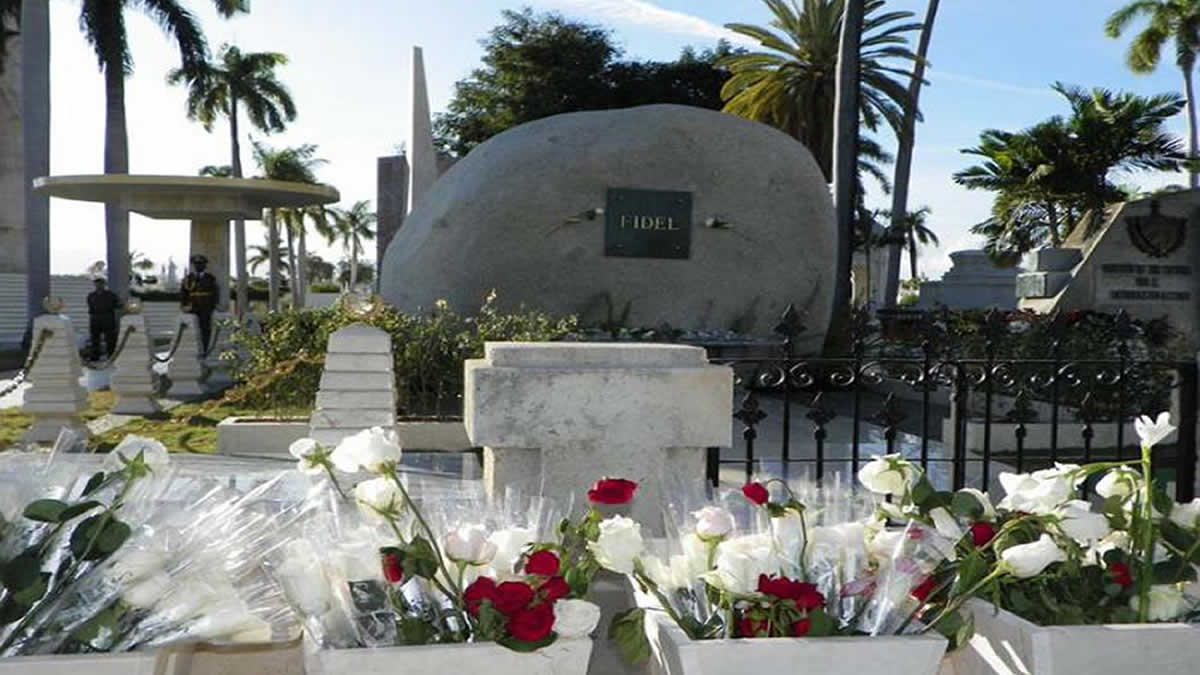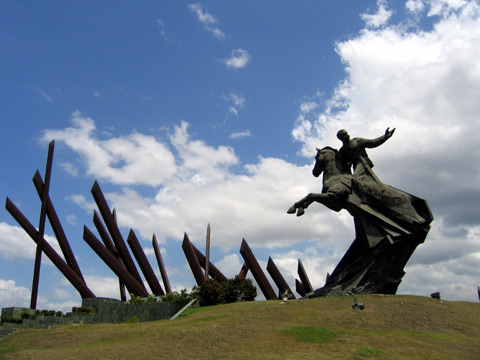 |
| The Rock on which is founded the first truly independent Cuba. This is Fidel's memorial. Like everything else in the Cementerio de Santa Ifigenia in Santiago. I couldn't get a decent photo -- we had to move too fast. So many people, in their best clothes with their children, were waiting in line to pay their respects. Island Cubans speak of him as 'Fidel' (see the plaque, simply named 'Fidel'.). Miami and Others are the ones who call him 'Castro'. This boulder was brought down from the Sierra Maestra, shaped and sculpted as his only memorial. His is so much smaller than Jose Martí's mausoleum, which is the towering focus of the eye when reaching the Cemetario, This is deliberate, denoting to history that Martí is the true father of Cuba's independence and Fidel is his apóstol . I honestly was moved, as I always am during periods in eastern Cuba, when contemplating the Revolution. |
 |
| This time around Santiago I saw the great art that is Jose Martí's mausoleum in Cementerio de Santa Ifigenia, en Santiago de Cuba. This was my first visit to Martí's mausoleum. The beauty of the design and execution, elegant, simple, harmonious and filled with so much historical content if one can read the symbol; ls another expression of monumental art that provokes genuine awe, joy (because it is so beautiful) and sorrow, for how, despite his death as a martyr to independence, the US saw to it that Cuba still was not at liberty. There is earth under his tomb (inside, at the bottom) from the United States, as he spent so much time there raising support for Cuban independence.
Cubans have so much justifiable pride in their history, and they remember it.
. . . . The Festival de Trova was being celebrated all through eastern Cuba, the birthplace of this great singer - songwriter balladeer form of music, which is part of the fairy tale of what, if anything, besides Fidel, everyone knows of Cuba, which is The Buena Vista Social Club.. At the same time we visited the cemetery, there were tours visiting the graves of the Buena Vista singers buried there.
Compay Segundo's tomb.
At one point as we ambled under our sun block, hats, long sleeves, shawls, and umbellas, to the great delight of strangers and Travelers alike, Ned broke into one of the famous songs -- the title of which I cannot ever recall, though it's one of the few songs to which I know the lyrics.
The sun, o the sun was brutal.
|
 |
| Monument to Antonio Maceo in the Plaza de la Revolución of Santiago de Cuba; by the time we got to this brilliant monumental art, I was O-U-T, and thus couldn't take my own photo this visit (I've been there previously though and have an entire album of photos of this impressive work). The sun was at brutal mid-day. It's really difficult to show the vast scale of this monument. Those spikes are memorials to the machetes wielded by the Afro-Cuban mambises in the wars against Spain, 1868 - 1878 (the end of the US War of Southern Rebellion and Emancipation also ended the African Slave Trade to Cuba) and the War of Independence 1895 - 1898 (which was highjacked by the US government on behalf of US corporations). I think . . . this was just about the last thing of Santiago we saw before driving back to Holguín's classic soviet era hotel Pernik from where the next morning we'd go to the airport. I wasn't feeling well, so had neither slept nor had any caffeine, so don't remember clearly. The Pernik is in the process of being renovated, one section at a time. I liked that hotel, and I slept really hard on that giant bed my last night and breakfasted beautifully in the restaurant the next morning, where several tables around mine hosted Midwestern and Southern US biz folks with their wives. |

. . . . The Fiesta del Fuego is the event to which the Ministry of Culture of Cuba invited us to participate, including a presentation of The American Slave Coast.
The most complete history of this event in English can be read on this site advertising tours to USians to visit. As can be seen, this isn't just "theoretical" and academic, but involves an enormous variety of music, art, theater and other kinds of cultural expressions, as well as fun in the streets, drinking, eating and dancing con el pueblo. Scroll down to History - Fiesta del Fuego.
Every July, the heat of Santiago de Cuba is tripled...added to the high temperatures normally felt in the eastern Greater Antilles is 1. the warm hospitality of the people of Santiago and 2. the Fiesta del Fuego.
The 'Feast of Fire', or 'the Caribbean Festival' is one of the most important cultural events for the Ministry of Culture of Cuba - organised by the 'Casa de Caribe'. It includes the participation of over 200 thousand artists and intellectuals from approximately 18 countries and a similar number of national participants, who meet between 3 and 9 July in forty spaces around the city of Santiago de Cuba, some 140 individual music and/or dance performances, magic/religious ceremonies, art exhibitions and theoretical activities to exchange anything having to do with history, religion and culture of the area. And that's one aspect that most distinguishes the Caribbean Festival from the rest of the international events held in Cuba! It is the merging of cultures together with the abundance of opportunities for academic discourse - all with folk art, tradition and expressions of identity of indigenous Caribbean peoples at the roots. Naturally attracting people from as far away as Australia, Hungary, Holland and Israel.
Since its founding in April 1981 this popular carnival has managed to honour the most authentic and spiritual roots of all Caribbean countries and fills the streets of Santiago de Cuba with a tantalizing mix of mysticism, music and wisdom. And apart from the popular street activities, other theoretical events as well such as: workshops on poetry, orality, theater, dance, religion and film series, concerts and theatrical scenery take place during the fesitval.
As a rule, each year the Caribbean Festival has paid tribute to a country or group of countries. Over the years heartfelt homage has been paid to Haiti, Guyana, Brazil, Puerto Rico, Dominican Republic, Venezuela, Mexico, Honduras, Africa, the francophone and anglophone Caribbean, Colombia, Panama, Netherlands Antilles, Aruba and Suriname.
But if there exists in the Caribbean Festival any expectations, especially at the grassroots level, they are without doubt the Fire Parade, which begins with a ritual salute Nzambi Congo, supreme entity among practitioners of Palo Monte religion, delivery Mpaka of the emblem of the Feast of Fire and the Burning of the Devil, a raging storm of drums one of the most central avenues of the city as a farewell to groups and participants of the current Festival.
Then, by the sea the huge effigy of the devil is set alight and the burning paves the way for the next Festival meeting in 12 months time.So, as can be seen from this site, anyone can go and see all the activities.*
-------------------------------
* How this tour company can charge such low prices -- really, $1150 for 20 days? Where are they staying and eating? Cuba is very pricey for even minimal comfort. Of course el V's charges include payments to all the groups and artists that perform for his Postmamboists, for 11 days. These aren't public performances to which tickets are bought. They are private performances, up close and personal, interactive with Q&A's etc.
Other tours targeting Cuba charge a lot more than the above organization, such as this one, which requests a $1300 deposit. Here's another one.



No comments:
Post a Comment